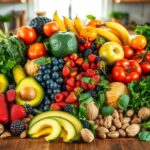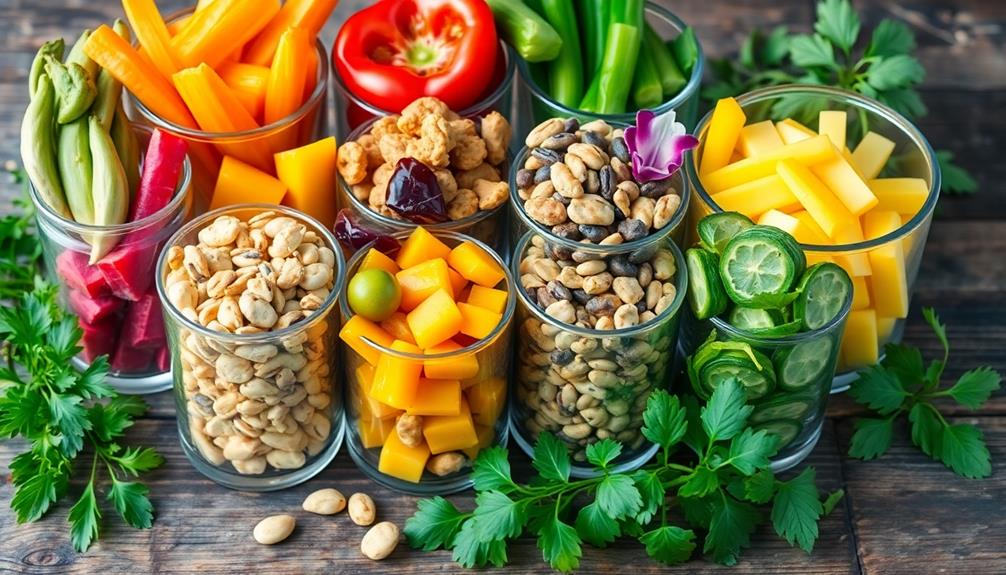To start a raw food diet, begin by incorporating one raw meal a day, like a smoothie or salad. Focus on a variety of fruits, vegetables, nuts, and seeds to keep your meals interesting and nutritious. Gradually increase raw meals as your body adjusts; listen to any digestive changes. Remember to pay attention to essential nutrients like vitamin B12 and iron, which can be low in a raw diet. Experiment with techniques like soaking and sprouting to enhance flavors. Interested in tips for meal planning and kitchen tools to ease your adjustment? Keep going to discover more!
Key Takeaways
- Start with one raw meal per day, gradually increasing as you become comfortable with the diet.
- Incorporate a variety of colors and types of produce to ensure balanced nutrition.
- Be mindful of potential nutrient deficiencies, particularly vitamin B12, iron, and omega-3 fatty acids.
- Experiment with different preparation methods like juicing, blending, and dehydrating to maintain interest in meals.
- Join online communities for support, recipes, and encouragement throughout your raw food journey.
Understanding the Raw Food Diet
When diving into the raw food diet, you'll discover it revolves around consuming unprocessed and uncooked foods, typically kept below 115°F to preserve their nutrients and enzymes. This diet primarily consists of raw fruits and vegetables, along with nuts, seeds, and sprouted grains.
By focusing on these fresh ingredients, you'll not only enjoy better flavors but also boost your healthy eating habits. Additionally, incorporating foods rich in antioxidants, such as celery juice, can enhance your overall health and support your body's detoxification processes celery juice benefits.
One of the key aspects of the raw food diet is meal planning. To maximize nutritional benefits, you should include a variety of colors and types of produce in your meals.
However, it's important to be aware of potential nutritional challenges. Deficiencies in vitamin B12, iron, and omega-3 fatty acids can arise, so consider researching supplementation options or incorporating fortified foods.
Advocates of this diet often highlight its role in weight loss due to the lower calorie density of raw foods compared to processed foods.
As you begin this journey, you'll likely experience increased energy levels and improved digestion, making the raw food diet a compelling choice for many. Just remember to stay mindful of your nutrient intake as you explore this vibrant way of eating.
Health Benefits of Raw Foods

When you eat raw foods, you're benefiting from nutrient preservation, as cooking can often reduce vitamin content.
Additionally, incorporating raw foods can enhance your overall health by supporting areas such as essential oils for respiratory health and boosting your immune system.
This diet also promotes enhanced digestive health, thanks to the high fiber levels found in fresh fruits and vegetables.
Nutrient Preservation Advantages
The preservation of nutrients in raw foods is a compelling reason to contemplate this diet for your health. Raw foods retain more vitamins, minerals, and enzymes compared to cooked options, which can greatly enhance your nutrient intake. Cooking can destroy up to 50% of water-soluble vitamins like vitamin C and B vitamins, showcasing the nutrient preservation advantages of a raw food diet.
Here's a quick overview of some key benefits:
| Nutrient | Benefit |
|---|---|
| Vitamins | Retained in higher amounts, boosting immunity |
| Minerals | Enhanced availability for better absorption |
| Antioxidants | Abundant in fresh fruits, reducing inflammation |
| Hydration | High water content aids in nutrient absorption |
| High Fiber Content | Supports weight management and keeps you full |
Enhanced Digestive Health
A raw food diet can greatly enhance your digestive health, thanks to its high fiber content and natural enzymes. By incorporating raw foods into your meals, you can experience a range of benefits that promote better digestion and overall well-being.
This aligns with the philosophical exploration of personal choices, emphasizing authenticity in one's dietary journey, as noted by existential themes.
Here are three key advantages of consuming raw fruits and vegetables:
- High Fiber: Raw foods are packed with fiber, which promotes regular bowel movements and helps prevent constipation. This can lead to improved digestive health and reduced discomfort.
- Hydration: Many raw foods contain high water content, aiding in hydration. Proper hydration is essential for peak digestion and nutrient absorption, ensuring your body gets the most out of what you eat.
- Enzymes: The natural enzymes found in raw foods assist in breaking down food, enhancing digestion and nutrient utilization in your body. This can help alleviate symptoms of digestive disorders, such as bloating or indigestion.
Additionally, research suggests that a high-fiber diet may lower the risk of developing digestive diseases, including colorectal cancer.
Nutritional Challenges to Consider

When you switch to a raw food diet, it's essential to be aware of potential nutrient deficiencies, especially in vitamin B12, iron, and omega-3s.
A well-planned raw food diet can help mitigate these risks by incorporating a variety of foods rich in essential nutrients, but it requires careful consideration and knowledge of raw food benefits.
You might also face digestive challenges as your body adjusts to the high fiber content of raw foods.
Staying mindful of these issues will help you maintain a balanced and healthy diet.
Essential Nutrient Deficiencies
Maneuvering a raw food diet requires careful attention to essential nutrient deficiencies that could impact your health. While raw foods are rich in vitamins and minerals, they may lack vital nutrients like vitamin B12, iron, and omega-3 fatty acids, typically found in animal products.
To maintain peak health, you'll need to plan your meals thoughtfully, reflecting on the importance of cold medications overview when dealing with common colds that might arise during dietary shifts.
Here are three key nutrient deficiencies to watch for:
- Vitamin B12: Essential for nerve function and blood formation, you might need to think about fortified foods or supplements.
- Iron: A significant component for oxygen transport in your blood, plant-based sources may not be as easily absorbed, so focus on foods like spinach, lentils, and seeds.
- Protein Sources: Insufficient protein intake can affect muscle health and overall body function. Incorporate nuts, seeds, and legumes to meet your needs.
Additionally, you may experience nutritional imbalances due to the exclusion of food groups, and the high fiber content of raw foods could lead to digestive discomfort.
Digestive Adaptation Issues
Shifting to a raw food diet can create significant digestive adaptation issues that may catch you off guard. One major factor is the high fiber content of raw foods, which can boost digestion but might also overwhelm your digestive system if introduced too quickly. This sudden increase in fiber can lead to bloating and discomfort, especially if you consume large quantities right from the start.
Additionally, incorporating a balanced diet rich in fruits and vegetables is essential for overall health, which can help in adapting to raw foods effectively.
Cruciferous vegetables, like broccoli and kale, are nutritious but can exacerbate these symptoms due to their complex carbohydrates. If you have pre-existing digestive conditions, these issues might be even more pronounced.
To ease your adjustment, consider the gradual incorporation of raw foods into your meals. Start with small portions, allowing your body to adjust before adding more.
Listening to your body is vital. If you experience bloating or other discomforts, it's a sign to slow down and assess what works for you.
Transitioning to Raw Foods
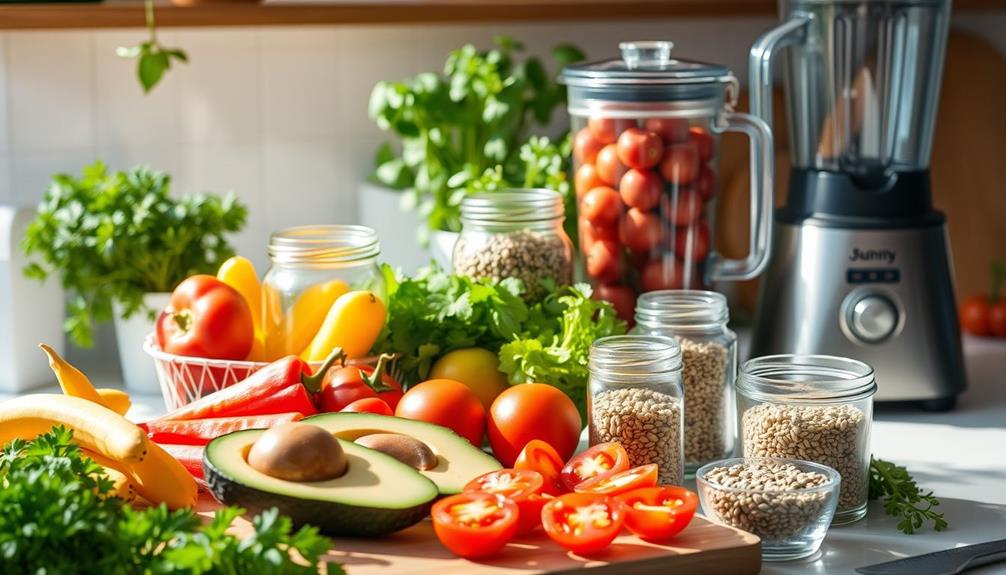
Shifting to raw foods can be an exciting journey that revitalizes your diet and energy levels. To make the change smoother, start by gradually incorporating raw meals into your daily routine. Here are three steps to help you along the way:
1. Begin with one raw meal a day: This could be a hearty salad or a rejuvenating smoothie. Slowly increase the number of raw meals as you feel comfortable.
Additionally, consider using aromatherapy techniques to create a calming atmosphere while preparing your meals, which can enhance your overall experience.
2. Focus on variety: Include a mix of fruits, vegetables, nuts, and seeds to create a balanced diet. This guarantees you're getting essential nutrients, like vitamin B and iron, that raw food diets might sometimes lack.
3. Experiment with preparation methods: Try juicing, blending, or dehydrating to enhance flavors and textures while sticking to whole foods.
As you move into raw foodism, monitor your energy levels and overall health. You may experience digestive adjustments, so it's vital to plan meals carefully and consider supplementation if needed.
Embracing healthy foods and being mindful of your daily calories will help you thrive on this vibrant diet.
Practical Tips for Beginners
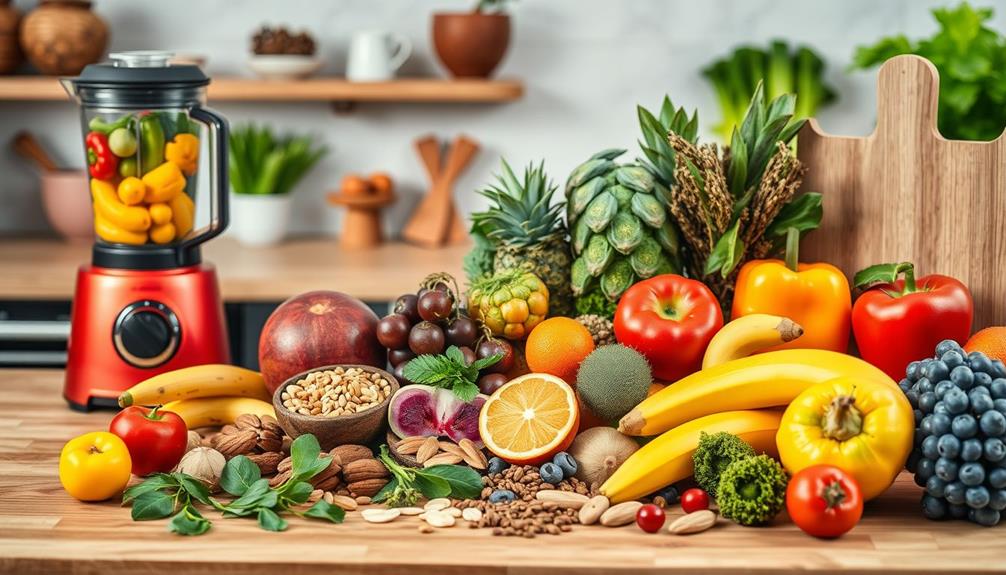
As you embrace a raw food lifestyle, having practical tips can make your journey smoother and more enjoyable. Start by gradually incorporating raw foods into your diet—aim for one raw meal per day. This approach eases the shift and allows your body to adjust to eating raw foods.
Additionally, consider the benefits of coffee and exercise performance to complement your raw food journey, as caffeine can enhance your energy levels and focus during workouts.
Focus on a diverse range of seasonal and local produce, including vibrant fruits, crunchy vegetables, nuts, and seeds, to guarantee a healthy, well-rounded nutrient intake.
To enhance your meal preparation, experiment with techniques like soaking, sprouting, and dehydrating. These methods can elevate flavors and textures, making your raw vegan diet more satisfying.
Joining online communities or local groups can offer invaluable support. You'll find encouragement, recipe ideas, and tips from fellow beginners traversing the raw food journey.
This connection makes the lifestyle more enjoyable and less isolating.
Essential Kitchen Tools
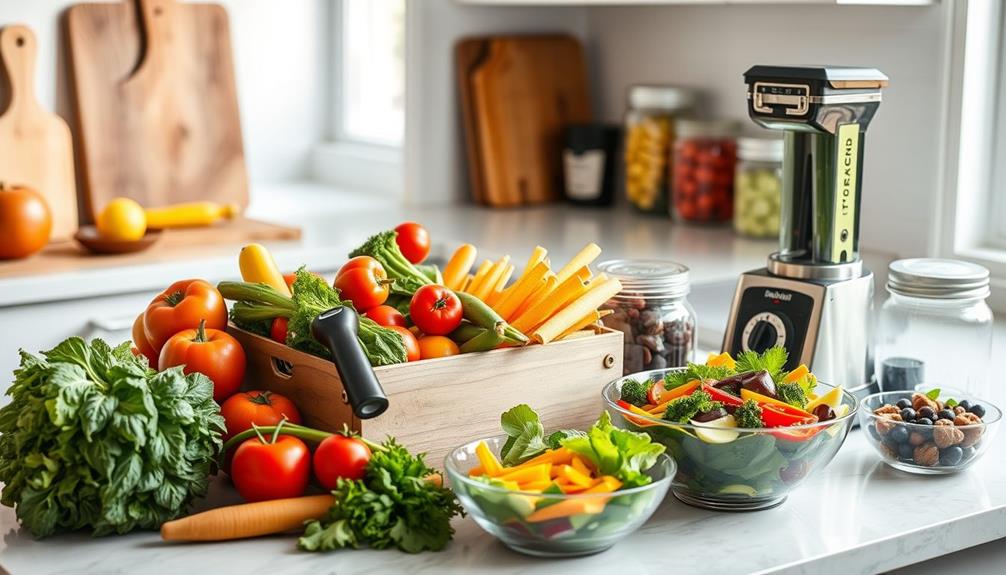
Having the right kitchen tools can make all the difference in your raw food journey. Investing in essential equipment will help you easily prepare delicious raw foods while preserving their nutrients.
For instance, understanding the various brewing methods can also inspire creative beverage options that complement your raw meals.
Here's a quick list of must-have tools:
- High-Speed Blender: A high-speed blender is vital for making smoothies, soups, and sauces while keeping temperatures below 118°F. This helps preserve the nutrients and enzymes in your unprocessed foods.
- Food Processor: A food processor streamlines your meal prep by efficiently chopping, shredding, and mixing ingredients. It's perfect for creating dips and nut butters that make raw meals more exciting.
- Dehydrator: A dehydrator is great for making dried fruits, vegetable chips, and raw crackers. It enhances flavors and textures without cooking, allowing you to enjoy healthy alternatives.
Additionally, don't forget sharp knives and cutting boards for safe and effective food prep.
Spiralizers can turn veggies like zucchini or carrots into noodle-like shapes, providing a fun twist on traditional pasta.
With these tools, you'll be well-equipped to explore the vibrant world of raw foods!
Meal Planning Ideas

With the right kitchen tools in hand, you can now focus on meal planning to make your raw food journey enjoyable and sustainable. Start by planning a variety of meals that incorporate raw fruits, raw vegetables, nuts, seeds, and sprouted grains. This mix will help guarantee a balanced nutrient intake and prevent monotony in your diet.
Incorporating natural elements like DIY Fire Pit Ideas can create a welcoming atmosphere for enjoying your meals outdoors.
Utilize meal prep techniques such as soaking, sprouting, and dehydrating to enhance flavors and textures while adhering to your raw food diet plan. Create a weekly menu that includes diverse options like smoothies for breakfast, salads for lunch, and raw veggie wraps or sushi for dinner. This keeps meals exciting and helps you eat a variety of wholesome foods.
Make the most of seasonal and local produce to maximize freshness and nutrition. Rotating ingredients based on availability not only enhances your meals but can also save you money.
Additionally, consider batch-preparing healthy options like energy balls or raw granola bars, guaranteeing you have quick and convenient snacks on hand throughout the week.
With these meal planning ideas, you'll find sticking to a raw food diet much easier and more enjoyable!
Community Support and Resources

Building a supportive community can make your raw food journey more enjoyable and sustainable. Connecting with others who share your passion for raw food diets can provide you with valuable insights, motivation, and resources.
This sense of community can also enhance your emotional and psychological growth, resembling the important key domains of development that shape individual experiences.
Here are a few ways to find community support:
- Online Communities: Join forums and social media groups focused on raw foodism. These platforms are great for sharing recipe ideas, success stories, and challenges you may encounter while adapting to a raw food diet.
- Local Raw Food Meetups: Attend workshops or cooking demonstrations in your area. These meetups not only offer hands-on experience but also allow you to connect with others who are equally passionate about raw food living.
- Engage with Nutrition Experts: Seek personalized guidance from nutrition experts or attend seminars. They can help you address specific health concerns and provide structured support tailored to your needs.
Frequently Asked Questions
How to Get Started on a Raw Food Diet?
To get started on a raw food diet, begin by adding one raw meal daily, exploring diverse fruits and vegetables, investing in essential kitchen tools, and planning meals ahead for a balanced, flavorful experience. As you gradually incorporate more raw meals into your diet, you’ll begin to experience the many raw food benefits. These include increased energy, improved digestion, better weight management, and higher nutrient intake. With time and dedication, you’ll find that a raw food diet not only nourishes your body but also tantalizes your taste buds with its vibrant and satisfying flavors.
How Do You Introduce a Raw Diet?
You're diving into a vibrant world of raw foods! Start by embracing one raw meal daily, gradually amplifying your intake. Discover delightful smoothies and salads, ensuring you savor every bite of this colorful, nutrient-packed adventure!
How to Eat Raw for Beginners?
To eat raw as a beginner, start with one raw meal daily. Explore diverse fruits, veggies, nuts, and seeds. Use a blender for smoothies, and join communities for support and recipe ideas. Enjoy the journey!
How Do I Become a Raw Foodist?
To become a raw foodist, gradually add raw meals to your diet, focus on fresh fruits and veggies, invest in good kitchen tools, and connect with supportive communities. Monitor your health as you changeover.
Conclusion
Incorporating raw foods into your diet can be an exciting journey, and you're not alone—about 3% of the U.S. population follows a raw food diet. This lifestyle not only boosts energy levels but also encourages creativity in the kitchen. As you explore this vibrant world of fresh fruits, veggies, and nuts, remember to stay connected with others on the same path. Embrace the challenge, enjoy the process, and watch your health thrive!




